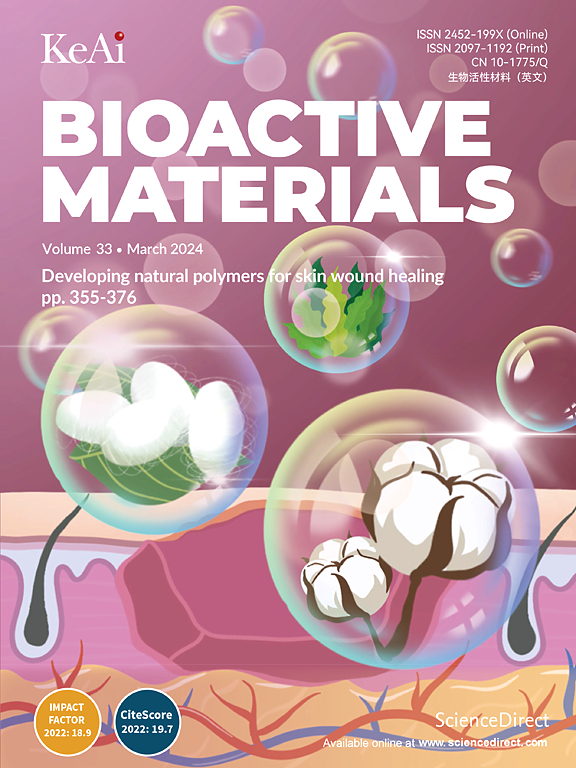In situ magnetic-field-assisted bioprinting process using magnetorheological bioink to obtain engineered muscle constructs
IF 18
1区 医学
Q1 ENGINEERING, BIOMEDICAL
引用次数: 0
Abstract
Tissue-engineered anisotropic cell constructs are promising candidates for treating volumetric muscle loss (VML). However, achieving successful cell alignment within macroscale 3D cell constructs for skeletal muscle tissue regeneration remains challenging, owing to difficulties in controlling cell arrangement within a low-viscosity hydrogel. Herein, we propose the concept of a magnetorheological bioink to manipulate the cellular arrangement within a low-viscosity hydrogel. This bioink consisted of gelatin methacrylate (GelMA), iron oxide nanoparticles, and human adipose stem cells (hASCs). The cell arrangement is regulated by the responsiveness of iron oxide nanoparticles to external magnetic fields. A bioprinting process using ring magnets was developed for in situ bioprinting, resulting in well-aligned 3D cell structures and enhanced mechanotransduction effects on hASCs. In vitro analyses revealed upregulation of cellular activities, including myogenic-related gene expression, in hASCs. When implanted into a VML mouse model, the bioconstructs improved muscle functionality and regeneration, validating the effectiveness of the proposed approach.

利用磁流变生物链接获得工程肌肉结构的原位磁场辅助生物打印过程。
组织工程各向异性细胞构建是治疗体积性肌肉损失(VML)的有希望的候选者。然而,由于在低粘度水凝胶中控制细胞排列的困难,在骨骼肌组织再生的宏观3D细胞结构中实现成功的细胞排列仍然具有挑战性。在此,我们提出了磁流变生物链的概念,以操纵低粘度水凝胶中的细胞排列。这种生物链接由甲基丙烯酸明胶(GelMA)、氧化铁纳米颗粒和人类脂肪干细胞(hASCs)组成。细胞的排列是由氧化铁纳米颗粒对外部磁场的响应性调节的。研究人员开发了一种使用环形磁铁进行原位生物打印的生物打印工艺,从而获得了排列良好的3D细胞结构,并增强了对hASCs的机械转导效果。体外分析显示,在hASCs中,细胞活性上调,包括肌生成相关基因表达。当植入VML小鼠模型时,生物构建体改善了肌肉功能和再生,验证了所提出方法的有效性。
本文章由计算机程序翻译,如有差异,请以英文原文为准。
求助全文
约1分钟内获得全文
求助全文
来源期刊

Bioactive Materials
Biochemistry, Genetics and Molecular Biology-Biotechnology
CiteScore
28.00
自引率
6.30%
发文量
436
审稿时长
20 days
期刊介绍:
Bioactive Materials is a peer-reviewed research publication that focuses on advancements in bioactive materials. The journal accepts research papers, reviews, and rapid communications in the field of next-generation biomaterials that interact with cells, tissues, and organs in various living organisms.
The primary goal of Bioactive Materials is to promote the science and engineering of biomaterials that exhibit adaptiveness to the biological environment. These materials are specifically designed to stimulate or direct appropriate cell and tissue responses or regulate interactions with microorganisms.
The journal covers a wide range of bioactive materials, including those that are engineered or designed in terms of their physical form (e.g. particulate, fiber), topology (e.g. porosity, surface roughness), or dimensions (ranging from macro to nano-scales). Contributions are sought from the following categories of bioactive materials:
Bioactive metals and alloys
Bioactive inorganics: ceramics, glasses, and carbon-based materials
Bioactive polymers and gels
Bioactive materials derived from natural sources
Bioactive composites
These materials find applications in human and veterinary medicine, such as implants, tissue engineering scaffolds, cell/drug/gene carriers, as well as imaging and sensing devices.
 求助内容:
求助内容: 应助结果提醒方式:
应助结果提醒方式:


